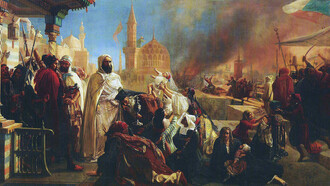The Amazigh have lived in North Africa for over 10,000 years (compared to only 1,500 years for the Arabs). And even though they are recognised as the first inhabitants of the region, and Amazigh women have played a historical role, they are the least studied and least publicly debated subjects in the countries of North Africa, and their role in history is almost totally ignored in teaching manuals and school books, even in Morocco and Algeria, where the Tamazight language is taught and enjoys a certain degree of recognition, unlike in Tunisia, where Amazigh civil society is struggling to make itself be heard by the Tunisian state.
Custodians, however, of an invaluable civilisational heritage, Amazigh women, known for their strength, bravery and attachment to their freedom, had to face the invasions of the Arabs who came from the East to conquer North Africa:
One of the women of character who deeply marked their arrival in Ifriqya, now Tunisia, was Dihya ⴷⵉⵀⵢⴰ, the Kahena, as called by the Arabs, who succeeded in uniting the called "Berber" tribes, Amazighs who refused to submit to the Arabs. She was a warrior-strategist, a leader of men in battle who, at age 22, succeeded in thwarting their many attempts to advance. A leader as she would have been called today, a shocking fact for the Arabs who, steeped in the Muslim patriarchy, considered her a witch, an enemy of Islam, otherwise how could she have slowed down the advance of Allah's warriors if not by using magical powers? Among her victories, was the battle of the camels. For a few years, she governed an independent Amazigh state, from the mountains of Aurèsès in Algeria, crossing Tunisia, to the oases of Gadamèsès in Libya (695-700/703). Sources vary as to whether she died in battle, sword in hand, or by suicide, swallowing poison, rather than being taken by the enemy.
Through their multiple periods of invasion, the Arabs, who had become sufficiently numerous, established their model of patriarchal society in the Maghreb, (North Africa) to erase the Amazigh identity. However, the Amazigh society was matriarchal and the polygamy authorised by the Sharia of these Muslim conquerors was mostly refused by Amazigh women, who imposed on the newcomers that the Amazigh wife refuses that the Muslim husband takes a second wife.
Often cited as being at the forefront of women's rights in the MENA region, due to their unique status since the adoption in 1956 of the Personal Status Code (PSC) in 1956, Tunisian women became broadly involved in the country's development. More recently, they have played a central role during the democratic transition following the uprising of 2011. However, Tunisia's gender equality ranking dropped from 90th to 124th out of 153 countries between 2006 and 2020, according to the Global Gender Gap report 2020 World Economic Forum's publication on gender inequality. Although women represent 67% of higher education graduates, unemployment affects them twice as much (22.5%) as men (12.4%). This disparity is even more exacerbated in the interior regions of the country (Gabes, Kasserine, Jendouba, Kébili, Gafsa and Tataouine) where the female unemployment rate reaches an average of 35%. In addition, only 23.3% of new housing loans are granted to women, and they continue to be victims of global violence of at least one form of violence (physical, sexual, psychological or economic). Not to mention the acts of intimidation against women entrepreneurs who are involved in transforming natural resources into high-value-added products, offering an opportunity for inclusion and financial autonomy to other rural women.
The condition of Tunisian Amazigh women is therefore linked to the current political, economic, social and cultural contexts.
So this lack of equality in terms of economic rights negatively affects women who are seriously disadvantaged in accessing credit, land ownership and financial products. This inequality undermines their entrepreneurial or business initiatives and affects their financial autonomy. According to the Global Gender Gap Report 2020 of the World Economic Forum on gender inequality, only 2.9% of Tunisian companies have a female majority. Thus, the predominant role of guarantees in determining the granting of credit, combined with the inheritance code stipulating that women only inherit half the share of men of the same degree of family descent, constitute major obstacles to women's economic rights. Despite the appearances, Tunisia has really experienced a setback in its achievements since the Islamists came to power, due to a reading of history made exclusively by men, influenced exclusively by patriarchal theses and an ideology imported from the Arab-Islamic-Salafist Middle East, which reduces the role of women, marginalises them and excludes them from the official history of the various North African countries.
The Amazigh woman nowadays is under a double attack, on her femininity and her linguistic and cultural identity. Not only does she have to fight to preserve her legitimate rights as a Tunisian woman, but despite her apparent good performance compared to other countries in the MENA region, the situation in Tunisia is quite alarming, and the achievements of women are fragile after the Islamist takeover, and their confirmation after the election of the current president, who claims to strengthen the patriarchal model and considers equality between men and women as not being in line with religion. The road to equality, therefore, remains long and full of pitfalls.
The Tunisian Amazigh woman once considered in Amazigh culture as the equal of the man, and the main guardian of the Amazigh language must now fight against the dominant Arab-Muslim culture. The energy, courage and dynamism of today's Tunisian woman remain a unique feature in a region where gender inequality persists.
Yet in the Amazigh tradition, women have always been treated with the highest respect by their communities. They were involved in family decision-making, heritage rights, and education. They had the responsibility to preserve cultural traditions. The work of men and women was clearly distinct but always recognised as being of equal value. There are still signs today that their status is far better than the one proposed by an obscurantist, backwards-looking ideology that is becoming more and more widespread. Signs in Amazigh customary law "izrf" such as "Tamazzalt" a right to equal sharing of property between husband and wife who divorce (finally adopted by the family code), penalties against the one who abuses a woman, who violates her or who is incorrect against her, mixed collective dances (ahidous, ahwach) mean community expression, a matrilineal lexicon (ultma/gma, amghar/tamghart, ...). In ancient history, Amazigh women (Dihya, Tinhinan, Zineb Tanfzaouit…) occupied an important place and were sometimes at the head of kingdoms or at their source in North Africa, "the Maghreb".
Traces of the ancient matriarchal order of Amazigh society, therefore, persist in the terminology of certain words. Thus the etymological origin of the words "uma" and "ultma", which respectively designate brother and sister, derives from the words "mis n yemma" and "yellis n yemma", which would mean son and daughter of my mother, always about the mother! Amazigh women have thus had the merit of passing on, through the ages, the Amazigh cultural heritage, exceeding "three thousand years of history", with the Amazigh language persisting from the Neolithic period to the present day. Emna Ben Miled. In addition to managing their homes and raising their children, women play an essential role in preserving the Amazigh artistic and cultural heritage through their work in fields such as textiles, music, poetry and dance.
Thus, through this plural ante-Islamic history (Punic, Carthaginian, Roman, etc.) and despite homogenization, the Tunisian Amazigh culture, even if diminished, was waved as a sign of 'Tunisianness', of Tunisia's local and specific roots. In this regard, the idea of belonging to the 'Mediterranean' is a cultural alternative to the Arab world and is a means of theoretically distancing oneself from an established form of Arab nationalism. But Amazigh culture must not be used as a mark of authenticity, nor as a stamp attesting to the local, ancestral character of the past, intended for tourists and for national history as one of the local facets of the heritage that forms the "mosaic" of Mediterranean and tolerant Tunisia.
The Amazigh women weavers, embroiderers and potters are far away from the time when a woman, Dihya, took on the defence of a whole people. They are chained to their loom, as in Chenini, known for its ancestral art of weaving, one of the rare bastions of Amazigh identity in Tunisia thanks to its location on the slopes of a mountain that offered it a defensive position, In the past, it was an ideal defensive position when the Arab tribes swept through the Maghreb or, as in Sejnene, where the women have been making clay dolls and various utilitarian and decorative articles for living for thousands of years.
Except for some women who have formed associations and are self-sufficient, such as Sejnenia, many are unfortunately dominated by a man, a husband, son or brother, claiming that Amazigh women today are shy and do not know how to promote their products.
Some North African countries, namely Morocco and Algeria, despite having officially recognised their native Amazigh language and identity in their constitutions, have not yet made any reforms to their school textbooks to update their collective memory and enable new generations to reconnect with their authentic history, with its bright and dark pages.
A new rereading of the history of North Africa, expected and demanded, could not be rewritten without Amazigh women. Most Amazigh activists are aware that as long as Amazigh women are marginalised, the community and above all Amazigh culture as a whole will be marginalised and in danger.















